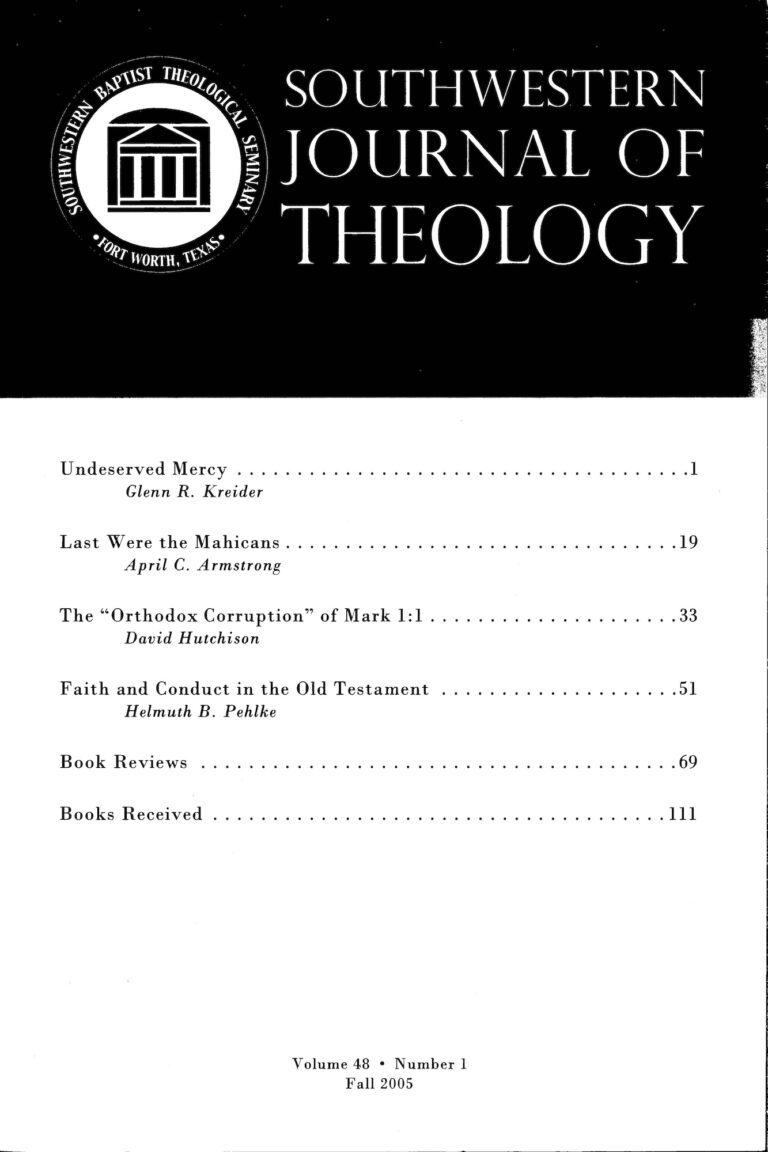
Southwestern Journal of Theology (48.1)
Southwestern Journal of Theology
Volume 48, No. 1 - Fall 2005
Editor: Paige Patterson
By Pamela R. Durso and Keith E. Durso. Brentwood: Baptist History and Heritage Society, 2006. 224 pages. Hardcover, $29.95.
Deftly drawing upon the often overlooked resources available in our Southern Baptist Historical Library and Archives in Nashville, Pamela and Keith Durso have provided a self-described “brief narrative introduction” to the history of Baptists in the United States (9). Rather than following the traditional approach of examining institutions, the Dursos set out to “focus on the people who formed those institutions and organizations,” and herein lies one of the attractive features of the book (9). Teeming with unique photos and illustrations, The Story of Baptists in the United States looks and reads more like a cherished coffee table book than your dusty stored-in-the-closet college textbook. Both the approach and the book’s design have produced a volume that should draw the time and attention of many. The idea of a more readable volume is a welcome relief to those of us who desire to see more people in the pews aware and reading the rich history of our Baptist past.
Within the covers and amid the pictures lie some very helpful and original chapters as well. Starting with a brief look at Baptist beginnings in England, the Dursos focus on John Smyth and the General Baptists to set their chronology on its path. Crossing over to Rhode Island and Roger Williams, the Dursos tell the story of Baptist advance from the seventeenth to the twenty-first century. It is chapters such as the fifth chapter on Baptists’ westward movement that stand apart as the Dursos comment on the rarely mentioned, yet critical and fascinating, history of Baptists in Tennessee, Kentucky, and Texas. The Dursos have succeeded in providing a concise history designed for an undergraduate course or even a church’s Sunday school class.
However, even with all these merits, there are a few items that regrettably make this volume one that cannot receive wide recommendation. First, while the majority of the chapters do provide as engaging an introduction as there is in the field of Baptist history, the reader subtly encounters a regular treatment of the state of women with respect to their roles in the churches, especially as it concerns ordination and preaching. This is not to say that this aspect of Baptist history should not be addressed. It should. However, like any issue that does not legitimately reside within the main of a history, it should be discussed with proper perspective related to its actual affect on the course of events. The Dursos, albeit not overbearingly, seem to bring this issue to the surface more times than is historically necessary.
For example, the Dursos consider the discussion in the 1960s over the “proper role of women in church and society” a “second controversy” that followed the first controversy that surrounded the suspension of Ralph Elliott’s Genesis commentary (183). Further, they call the ordination of Addie Davis an event that “rocked the convention,” and give two full pages to its description (183-85). However, the Elliott controversy, which led to the revision of the Convention’s statement of faith, receives only one page. Furthermore, the Broadman Bible Commentary controversy of 1969-70, an event that in conjunction with the Elliott crisis did more to raise the ire of the people in the pews, receives no mention.
Second, in the eleventh chapter the Dursos address what they term “theological controversy” in the twentieth century. However, when focusing on the inerrancy controversy of the 1980s and 1990s, the Dursos provide little description of the theological issues that drove the controversy and instead seek to remind the readers of how this event “split the convention, divided thousands of local Baptist churches, damaged hundreds of careers, and wounded numerous relationships” (185). To their credit, they do recognize that among conservatives and moderates there is not agreement “about the sources or outcomes of the conflict,” but the Dursos fail to interact with the documented theological problems such as those presented in Noel Hollyfied’s 1976 thesis at Southern Seminary, to name just one (191). Hollyfield’s analysis distinctly revealed the negative effects of his seminary’s teaching on a student’s commitment to orthodox Christianity.
The Story of Baptists in the United States is a book that should not go unnoticed. Indeed, pastors and professors alike should read it and appreciate its contribution to Baptist history. However, for the reasons noted above, pastors and professors should look for another book for use in the churches or the classroom. This one seems best suited for their coffee tables.





